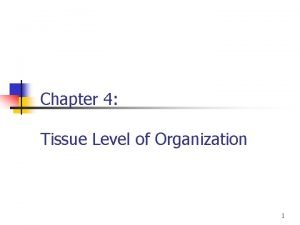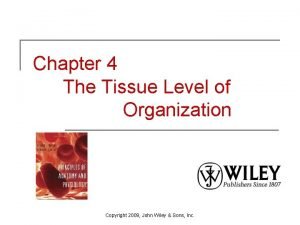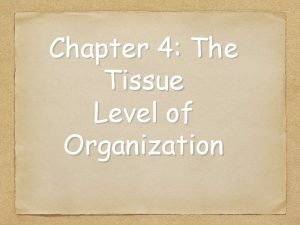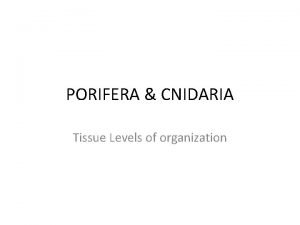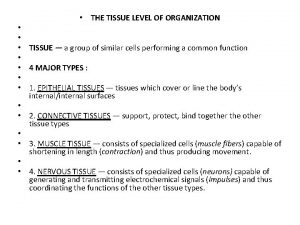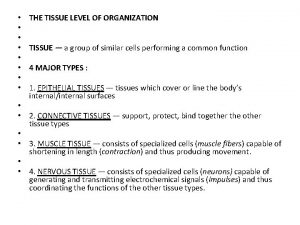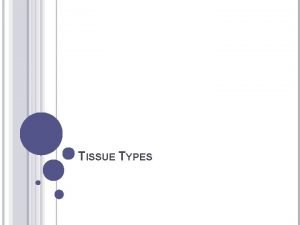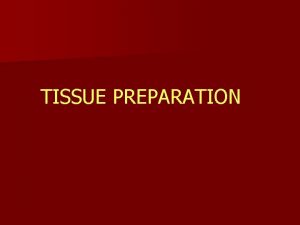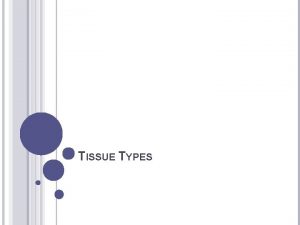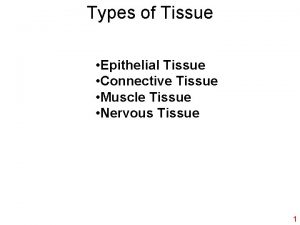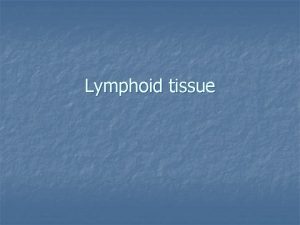Chapter 4 The Tissue Level of Organization Lecture




















- Slides: 20

Chapter 4 The Tissue Level of Organization Lecture Presentation by Lee Ann Frederick University of Texas at Arlington (heavily modified by GJC) © 2015 Pearson Education, Inc. 1

Review: Levels of Organization (section 1 -4) Cellular Level Chemical Level Protein filaments Atoms in combination Complex protein molecule Tissue Level Cardiac muscle tissue Heart muscle cell Organ Level Organ system level Organism level The heart The cardiovascular system © 2015 Pearson Education, Inc. 2

An Introduction to Tissues • Learning Outcomes • 4 -1 Identify the four major types of tissues in the body and describe their roles…. • 4 -10 Describe how injuries affect the tissues of the body. • 4 -11 Describe how aging affects the tissues of the body. © 2015 Pearson Education, Inc. 3

4 -1 Four Types of Tissue Type Role(s) - Covers surfaces/passages - Forms glands - Structural support - Fills internal spaces - Transports materials - Contraction! - Transmits information (electrically) 4

What tissue is this? Figure 1 -9 b Other examples? © 2015 Pearson Education, Inc. 5

Structural & functional traits of epithelial cells • Cell junctions • Polarity • Attachment • Innervation • Border outside environment (sometimes) • Many vesicles (sometimes) FUNCTIONS • Protection • Control permeability • Sense stimuli • Secretion • Regenerate quickly • Cilia (sometimes) 6

Figure 4 -1 The Polarity of Epithelial Cells. Basement membrane © 2015 Pearson Education, Inc. 7

4 -2 Epithelial Tissue • Intercellular Connections • Support and communication • CAMs (cell adhesion molecules) • Transmembrane proteins • Intercellular cement • Proteoglycans • Hyaluronan (hyaluronic acid) • Glycosaminoglycans © 2015 Pearson Education, Inc. 8

4 -2 Epithelial Tissue • Cell junctions • cells form bonds with other cells or extracellular material Figure 4 -2 © 2015 Pearson Education, Inc. 9

Figure 4 -2 b Cell Junctions. Embedded proteins (connexons) b © 2015 Pearson Education, Inc. Gap junctions 10

Figure 4 -2 c Cell Junctions. Interlocking junctional proteins Tight junction c A tight junction is formed by the fusion of the outer layers of two plasma membranes. © 2015 Pearson Education, Inc. 11

Figure 4 -2 d Cell Junctions. Cell adhesion molecules (CAMs) Proteoglycans d A spot desmosome ties adjacent cells together. © 2015 Pearson Education, Inc. 12

Figure 4 -2 e Cell Junctions. Basement membrane e Hemidesmosomes attach a cell to extracellular structures, such as the protein fibers in the basement membrane. © 2015 Pearson Education, Inc. 13

4 -2 Epithelial Tissue • Epithelial Maintenance and Repair • Epithelia are replaced by division of stem cells … located where? • What is the epithelial cell life cycle like? © 2015 Pearson Education, Inc. 14

4 -3 Classification of Epithelia Figure 6. 1 from lab manual (Marieb et al. ), 11 th edition 15

Simple vs. stratified epithelia © 2015 Pearson Education, Inc. 16

4 -3 Classification of Epithelia • Squamous Epithelia • Stratified squamous epithelium • Protects against attacks • Keratin protein adds strength and water resistance © 2015 Pearson Education, Inc. 17

Types of epithelia (see books for pics) Type Where found Simple squamous Simple cuboidal Simple columnar Pseudostratified columnar Stratified squamous Stratified cuboidal Stratified columnar Transitional 18

4 -3 Classification of Epithelia • Glandular Epithelia: endocrine and exocrine glands Figure 6. 2 from lab manual (Marieb et al. ), 11 th edition 19

What is secreted by endocrine & exocrine glands? 20
 Chapter 4 the tissue level of organization
Chapter 4 the tissue level of organization Chapter 4 the tissue level of organization
Chapter 4 the tissue level of organization Chapter 4 the tissue level of organization
Chapter 4 the tissue level of organization Porifera level of organization
Porifera level of organization 01:640:244 lecture notes - lecture 15: plat, idah, farad
01:640:244 lecture notes - lecture 15: plat, idah, farad Jaringan epitel dapat ditemukan di
Jaringan epitel dapat ditemukan di Chapter 3 the cellular level of organization
Chapter 3 the cellular level of organization The chemical level of organization
The chemical level of organization The chemical level of organization chapter 2
The chemical level of organization chapter 2 Process organization in computer organization
Process organization in computer organization Block organization essay
Block organization essay Pyramid of numbers
Pyramid of numbers Hát kết hợp bộ gõ cơ thể
Hát kết hợp bộ gõ cơ thể Ng-html
Ng-html Bổ thể
Bổ thể Tỉ lệ cơ thể trẻ em
Tỉ lệ cơ thể trẻ em Gấu đi như thế nào
Gấu đi như thế nào Tư thế worms-breton
Tư thế worms-breton Alleluia hat len nguoi oi
Alleluia hat len nguoi oi Các môn thể thao bắt đầu bằng tiếng đua
Các môn thể thao bắt đầu bằng tiếng đua Thế nào là hệ số cao nhất
Thế nào là hệ số cao nhất
